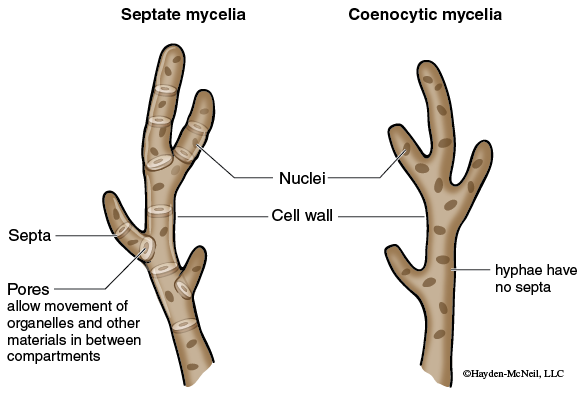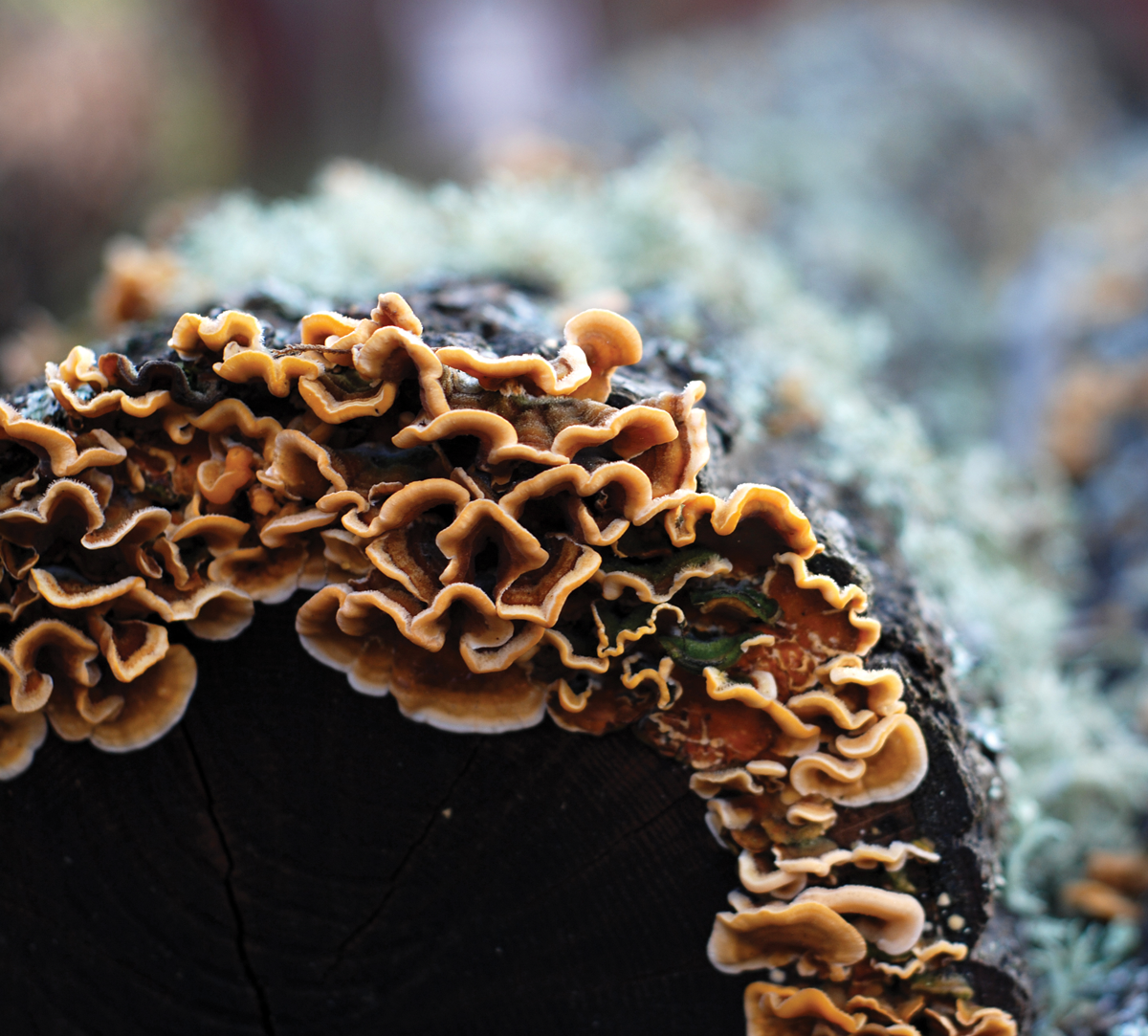Chapter 2. DIVERSITY IV—FUNGI
Learning Objectives
General Purpose
Conceptual
- Be able to compare and contrast the major groups within the kingdom Fungi.
- Be able to recognize and describe the structures important in fungi reproduction.
Background Information
The kingdom Fungi is part of domain Eukarya and consists of structurally and nutritionally distinct organisms. Although fungi were once thought to be related to plants, recent molecular evidence suggests that fungi and animals diverged from a common ancestor. In general, fungi are multicellular organisms composed of masses of filaments; however, there are a few species, including yeasts, which are unicellular. Individual filaments are called hyphae. The feeding network for the fungus is a mass of hyphae called a mycelium. In most cases the mycelium is hidden within the food source. Growth of the hyphae occurs at the tip and can be very rapid. Depending on the species, hyphae are partitioned into cells by cross-walls called septa, or they may be aseptate or coenocytic (meaning multinucleate). The septa are usually perforated which allows the protoplast to flow from cell to cell (see Figure 12-1).

The cell walls (i.e., the hyphal walls) are composed primarily of chitin, a polysaccharide similar to the chitin found in the exoskeletons of insects.
Like bacteria, fungi are everywhere on Earth. Fungi reproduce using spores which are easily airborne and as such are all over the Earth. Fungi are eukaryotic heterotrophs that absorb their food by secreting digestive enzymes into a food source. These enzymes catalyze the breakdown of complex molecules into smaller molecules that can be absorbed into the fungal cells. Because of this absorptive nutrition fungi must normally live in environments that are rich organic substances.
This absorptive mode of nutrition allows specialization of fungi as 1) decomposers (saprobes), 2) parasites, or 3) mutualistic symbionts.
Saprobic fungi are extremely beneficial because the digestive enzymes they secrete are responsible for decomposing dead plants and animals, fallen leaves, and wastes of living organisms, making it possible to recycle chemical elements. Some fungi actually are very specific, decomposing organic material from burned soil or animal urine. Other saprobic fungi secrete enzymes that digest materials valuable to us, causing wood to rot, fabrics to mildew, and mold to grow on food. On the LSU campus there are a number of fungi that specialize on living on the bark of live oak trees. The reproductive fruiting bodies on these can be seen most of the year on the trunks and undersides of branches (see Figure 12-2).
Parasitic fungi secrete enzymes that digest nutrients from the cells of living hosts. They cause many plant diseases, such as leaf spots, and a number of diseases in humans including ringworm, athlete’s foot, vaginal infections and thrush. Individuals with compromised immune systems are particularly vulnerable to fungal infections.

Mutualistic fungi are those that live in mutually beneficial symbiotic relationships. Two common mutualistic fungal symbiotic relationships are lichens and mycorrhizae. Lichens are symbiotic associations of unicellular photosynthetic organisms (either algae or bacteria) and fungi. These unique partnerships can grow in places that other organisms cannot grow (see Figure 12-3).

Mycorrhizae are symbiotic associations of fungi with the roots of vascular plants. Nearly every vascular plant growing in the wild has a mycorrhizal relationship with a fungus.
Fungi reproduce by the formation of spores. Spores may be produced asexually and sexually depending on the species. The specialized spore-producing structure forms on hyphae (see Figure 12-4).

Spores are produced in the reproductive fruiting bodies. Many species have elaborate and sometimes bizarre types of fruiting bodies to enclose, protect, and promote the spreading fungal spores to new habitats. Spores are usually dispersed by wind or water (including rain), or by animals. The spores will germinate to form a new fungus when conditions are favorable. Depending on the species spore formation may occur as part of sexual or asexual reproduction. In addition, a few fungi regularly reproduce asexually by fragmentation of their hyphae. Other species can also use this method as an alternative means for reproduction and dispersal.
Sexual reproduction in many fungal species includes two distinct stages. In the first stage, plasmogamy, the cytoplasm of two compatible hyphae or asexual spores fuse resulting in dikaryotic hyphae designated as n + n because the haploid nuclei do not fuse. During the second stage, karyogamy, the haploid nuclei fuse, resulting in the diploid stage. Some fungi may remain dikaryotic for years before the diploid stage is formed. The diploid stage undergoes meiosis to produce haploid spores.
Many fungi are economically useful. Commercial uses of fungi and their enzymes include the production of wine, beer, certain cheeses, various antibiotics and bread. Other fungi, such as mushrooms, are eaten regularly by humans.
For more about the general characteristics of fungal organisms view the following video: